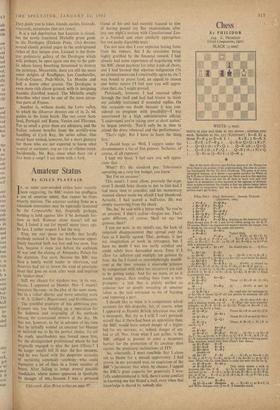Chess
By PHILIDOR 214. C. PROMISLO (Good Companions, 1921) BLACK (4 men)
WHITE (5 men)
WHITE to play and mate in two moves ; solution next week. Solution to No. 213 (KNuPpEaT): R—K Kt 4, threat P—B 4 or R—K 8. t. . . R x R ; 2 R—K 8. ...BxR 2 P—B 4. ...QxRorQxQ; 2 RxP. Q—Q 5 ch ; 2 Px Q. . Q—K 5ch ; Qx Q. Q—B 5 ch ; 2 P x Q. . . . Q—B 5 ch ; 2 Kt x Q. r.. . Q>: Kt or Q—Kt 6 ; Q—K 4.
One of the most effective anti-Sicilian players is the Hungarian Dely; here is yct another of his crushing wins, this time in a train- ing tournament for the Tel Aviv Olympics. The game is of some theoretical interest, as it shows a successful sacrifice by White of his K 11, one of the standard targets for Black attack in this opening. The lesson is the u. ual one we all have to Learn over and over again—it is dangerous to win material at the expense of develop- ment in open positions; the trouble is that one always hopes (when one yields to temptation) that this is one of the cases where the pitcher won't get broken.
White, DULY. Mark, BHDNARSKL Opening, SICILIAN. (Zinnowia, t964) ✓ P....4C 4 B 4
• Kt—K B 3 P—Q 3
3 P-904 P P 4 KS x Kt—K B 3 5 Kt—Q B 3 P 12 3 6 113—Q II 4 P—K 3 7 B— Kt 3 P—Q Kt 4 Starting on the downward path; Black should play 13—K 2 and 0-0 before going for the K P. Of course, Black—an experienced master—knows his danger, but lie thinks he can snatch the pawn and survive.
8 P—B 4 B—Kt 2
g P—B 5! . . . Typical Dely.
P—K 4 9 . . P xP; to Kt x P, Kt x Pt 11 31, P—Q 4 (i . . Kt—I3 4?; 12 Kt x Kt P chl); 12 t x1C1!. PxKt; 13 Kt xP ch!, K—Q 2; 14 Q xPch with is winning game. to Kt (4)—K z Kt x PP He should play 10 ... Q Kt— Q 2. Kt x Kt lixKt .12 11—Kt 2 12 Q—Kt 3 ch; t3 K—I2 1, 11—K 2; 14 Kt-13 3, I3—Kt 2; 15 Kt—Q 5 is no better for Black.
73 Kt-11 3 13--K z
14 Kt—Q 5 B—K B 3 14. . . 0-0?; is refuted by P—B 6!, El' x P; 16 Kt x B ch. P x Kt; 17 13—It 6! and 14 • • • Kt—Q 2 is met by t5 Q—Kt 4 since if is . . 0-0; there is
16 K—R 61, I3—B 3; 17 Kt x 13 ch, Q x Kt; t8 B—K! 51 Black is positionally lost.
15 11—K 3 Kt—Q
r6 Q—R 5! • Threat 17 Kt x13 ch, Q >, Kt; t8 11—Kt 51 r6 . . . P—R 3 16 . . 0-0; is met by 13—B 3—I1 3.
17 Q R—Q r . He could win the exchange by t7 Kt—Kt 6 (threat Q—P ch) but prefers to maintain the full blast of the attack.
R—K B r 11 17 ... 0-0; then 1812—K 3 with a winning attack, el. 18 . . . 13-1(14? (the most plausible defence); 19 It B QxB; 20 Q Q!, xQ; 21 Kt—K 7 eh, K—I3 2; 22 R-12 3 mate.
18 Q—B 3!Threat Kt x B ch and Q x Q 13. • . . . .42-Kt t ry Q—Kt 31. . . Threat Kt x13 ch and Q—Kt 7. Q—Q I 20 R—Q 3 . Threat IC R—Q 1, Kt x.B eh
and It x Q
Kt-11 4
sr Bx Kt! P B
22 R—K ! P—B 5? Or 22 .. I; 23 Kt x13 ch, P x Kt; 24 Q—Kt 7, P—I3 5; 24 Q x13 P, R; 26 It x ch, Q x R (otherwise he is mated); 27 x Q ch with it winning game. This, however, would have been B nek's best chance.
23 RxPcht BxR
24 2. ch K—S 2 zs t—Kt 6 K— 3 double ch 26 Kt x P1 P Kt 26 . . , Q x R.; 27 Kt—R 5 ch,
K—Kt 3; 28 P K x Kt; 29 Q—B 7 ch, K—Kt 5; 3o Q-13 3 mate. White will not allow Black to come out with two Its for Q.
27 B—R 4 ch K—Ks 3
28 R—Q 6 ch! . . . Dely rarely misses a trick in positions like this. If 28 . . . Q x 12; in reply, then 29 Q x Q ch and now (a) 29 K-11 2; 3o Q—B 5 ch, 1C—Kt 1; 31 Q x R ch, etc.. or (b) K—R 4; 3o Q—B 5 ch, K x B; 31 P—Kt 3 eh, P x P; 32 P x P mate.
28 . . . K—R 29 q—Q 4 chi Resigns 29 . . K—Kt 1; 30 R x Q eh and White emerges with Q for R. A beautiful attack.






































 Previous page
Previous page